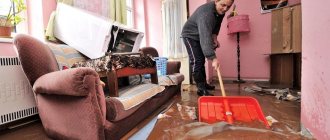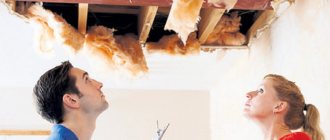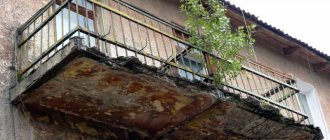Flooding of an apartment is a nuisance that occurs in the life of almost every person. It’s especially sad if it happens immediately after repairs. In the Bay, the culprits are the neighbors living above or the organization that maintains the apartment building. Those responsible for the bay do not always strive to voluntarily compensate for the losses caused. To receive compensation, you need to know how to act in the event of a flood and which authorities to contact with this problem.
Procedure
As judicial practice shows, when an apartment is flooded, it is important to decide on two questions:
- who is responsible for the bay;
- what is the extent of the damage caused?
It is in the interests of the culprit to prove that he is not responsible for the problem or to minimize the amount of compensation. To prevent this from happening, after discovering a bay, a citizen must call the emergency service and invite representatives of the management company that maintains the house.
Each homeowner enters into an agreement with the management company, in which the company assumes the obligation to manage the apartment building. On this basis, the organization performs on its own or engages third-party companies to service property that is in common ownership.
Important! If the agreement is concluded not with the management company, but with the HOA, then this organization is responsible for maintaining the property that is in common ownership of the residents. For this reason, in the event of an accident in an apartment, representatives of the HOA are invited.
Until all specialists visit the apartment, the consequences of the flood cannot be cleaned up. Everything must remain in its original form.
Statement of claim for apartment flooding
Agreeing on voluntary compensation for damage is sometimes not so easy!
Those responsible for the accident think that the victim is demanding an inflated amount or they do not admit their guilt at all.
There is only one way out - to go to court with a claim for compensation for material damage, and in some cases, moral damage.
The claim must be filed in the district court at the plaintiff’s place of residence, that is, the location of the damaged apartment.
All available documents must be attached to the claim, including the assessment report to justify the required amount of compensation.
The law does not specify in what form the claim must be filed. But oral claims are not accepted for consideration.
Therefore, the claim must be submitted only in writing. It must contain the following information specified in Article 130 of the Code of Civil Procedure and 131 of the Code of Civil Procedure of the Russian Federation.
This:
| Information about the court | in which the case will be heard |
| Information about the parties to the process | for individuals, their initials, as well as passport data, are indicated, and for legal entities - all information from the constituent documents, with the exception of bank details |
| Cost of claim | it is determined by the amount of damage to be compensated. For this purpose, the appraiser's report is attached |
| Document confirming payment of state duty | The amount of the fee depends on the value of the claim. It is calculated as a percentage of the cost of the claimed damage. |
| Subject of the claim | here the applicant describes everything that happened to his apartment and property, what happened, whose fault the spill happened and other information that is relevant to the case and provides the necessary information for the court |
| Request for compensation | and moral damages from the culprit of the accident |
| List of documents | which the plaintiff attaches as proof of his words, as well as to justify the amount of compensation to be reimbursed |
The claim is signed by the plaintiff. After drawing up and signing, the plaintiff must make as many copies as the parties to the process, and send a copy of the claim to everyone for review.
The defendant must receive a copy of the claim without fail. Otherwise, he has the right not to appear in court due to the fact that he was not properly notified.
If the property is owned
In Art. 30 of the Housing Code of the Russian Federation states that the owner of a residential premises must maintain it in a condition suitable for habitation.
This means that all current communications that take place in the apartment must be in working order.
Read more: How to collect a debt from the heirs of a deceased debtor
Read the existing algorithm of actions in case of flooding of an apartment here.
If it is established that the spill occurred due to the fault of the owner of the apartment above, then he will fully compensate for the damage caused to the apartment below.
For example, ownership of an apartment was acquired during the privatization process.
This apartment building used to be state-owned, so it is still maintained by the housing office (in most cases).
Service company employees must monitor the condition of utilities in each apartment.
This means that at certain intervals they must visit apartments and draw up communications inspection reports.
Owners must not interfere with inspection. After each inspection, a certificate is signed indicating that it was completed.
If a problem is discovered during the inspection, housing office employees will have to fix it as soon as possible. They will have to do this at their own expense.
But you often hear the following phrases from utility workers: “The pipe is yours – you have to pay for it!” The position is fundamentally wrong!
If the owner of the apartment is sure that the housing office is the culprit of the flood in the lower apartment, then he must be guided by the provisions of Resolution No. 354 of May 6, 2011.
In addition, if the residents of the damaged apartment sue the apartment from above for damages, then the residents of the “leaky” apartment have the right to file a counterclaim for flooding of the apartment to the Housing Office if they believe that it is entirely their fault.
Non-privatized
The owner of non-privatized housing is the state. It is the authority that is responsible for maintaining the apartment building in a condition suitable for habitation.
In the event of force majeure, the state must reimburse the costs of urgent repairs.
In order to relieve itself of such obligations, the state, represented by local governments, enters into an agreement with a service company, that is, with the housing office.
Now this organization is responsible for maintaining the house.
Since the owner of non-privatized housing stock is the state, the citizens who live in such apartments are tenants.
They can only use the housing. They have no right to dispose of it and own it!
If the flooding of the apartment from below was due to the fault of the tenants (for example, they did not take care of the water in the bathroom and it overflowed), then they will be found to be responsible for the accident. They will compensate the neighbors below for the damage.
And if there is a break in a pipe located in a common riser, then the housing office will be considered the culprit for the spill.
He will fully compensate for the damage to the damaged apartment.
But in practice everything is not so simple! It is quite difficult to prove the guilt of the service company, since the tenant is responsible for maintaining the equipment.
In addition, the employer is obliged to take appropriate measures to eliminate detected problems.
That is, the tenant of the apartment due to which the flood occurred will have to prove that he did not know that the equipment (for example, a pipe that burst) was already in unusable condition.
While the Housing Office will claim the opposite! To avoid troubles, all plumbing equipment in a non-privatized apartment must be replaced by housing office specialists.
For example, an employer noticed that a pipe in his common riser was starting to leak.
He must immediately call the housing office employees so that they can repair the faulty equipment.
An application for the removal of a specialist must be made in writing, and after all work has been completed, the customer must sign the work order.
Then, if it is this equipment that causes the apartment to flood from below, it will be quite easy to prove the housing office’s guilt!
Cooperative ownership
If the apartment is located in a housing construction cooperative, then it will actually become the property after the payment for it has been fully paid.
Until then, it remains the property of the housing cooperative. Therefore, all the provisions on non-privatized apartments and flooding can be applied in this case.
Sample claim
A sample claim for compensation for damage (material) caused to an apartment due to flooding can be seen here.
Drawing up an act
During the visit, company representatives draw up an act on the filling of housing. When drawing up a document, the presence of two parties is mandatory - the victim and the one who is allegedly responsible for the occurrence of this problem. The act specifies the following points:
- time and place of the accident;
- what caused the flooding;
- degree of damage;
- a description of all interior items and furniture damaged by the flood is carried out;
- the cause of the accident;
- personal data and positions of all official representatives of the company with which the agreement is concluded, present at the site of the flooding.
Based on the report, the amount of damage is calculated. To clearly demonstrate everything that is stated in the document, it is recommended to attach photos and video materials to it.
Correct filing of a lawsuit
The past actions of the management organization may not have satisfied the requirements of the victim or he may not have received the expected response. Then the owner will have to apply to the court for proceedings. When assessing the damage incurred up to 50 thousand rubles, you need to apply to the magistrate, above the specified amount - to the district judge.
The claim must be submitted in writing. The top group of details indicates the name of the court, the full name of the applicant and the defendant. The application amount is also added here.
- The name of the judicial authority to which the petition is sent.
- The full name of the defendant, registration address, cell or landline phone number.
- The material compensation or moral compensation determined by the appraiser, however, the costs are contained in a separate paragraph of the appeal.
- The name of the written document.
- The basis of the lawsuit is when, where and how, as well as the circumstances under which the legal rights of the apartment owner were violated, the evidence base regarding the citizen’s appeal to the highest authority.
- A mandatory element of judicial practice regarding the flooding of an apartment by neighbors from above is an indication of the cost of damage for each damaged unit, and possible moral damage.
- A complete list of attached documents is provided.
The petition is summarized by the date of its preparation and the signature of the applicant.
- the statement itself;
- civil passport;
- receipt for payment of state court tax;
- certificates of home ownership;
- Bay Act, other possible forms;
- documents about the actual material loss caused.
An addition will be a method for calculating flood damage to an apartment.
The document is written proof that the apartment was flooded by the upstairs neighbors. If such a document is not drawn up at all or in a timely manner, the plaintiff will not have to hope for compensation for damages after the meeting.
- the victim;
- the culprit of the accident, if the cause is established and responsibility is recognized;
- the authorized housing office that manages this multi-storey building or HOA.
When filling out the form, the listed persons have the right to be in the apartment or absent, sign the document or refuse. In the latter case, a note is made about this, which is secured by the approval of other participants in the procedure.
What to do if your neighbors below are flooded.
The act is sealed with the signatures of two disinterested persons, one sample is given to the victim - the consumer, the second - remains with the representative of the management organization - the executor. The latter is an authorized legal entity that provides utility services to residents of the house. The owner is considered the consumer.
However, the deadlines for completing such a document are not always strictly observed, since many apartment owners do not know that the countdown begins immediately after a call to the emergency dispatch department.
Sometimes the housing office draws up two acts. The first document is immediately after the flood, the second is a couple of weeks later, when everything in the apartment dries out a little and damage is discovered that was invisible after the flood.
Harm assessment
An appraisal company will help determine the exact amount. The injured party chooses which organization to contact - private or public.
When you have a conclusion with the amount of damage in hand, you must contact those responsible for the flood with this document. It is recommended to reach an amicable agreement with the neighbors of the apartment or representatives of the management company.
Important! The outcome of the negotiations depends on the amount of damage and the willingness of the guilty party to bear responsibility for the flood. If victims demand small compensation, the perpetrators pay it to avoid litigation. If an amicable agreement is reached, an agreement is concluded between the parties. It indicates the exact amount of payments, as well as the date by which it must be transferred to the victim’s account or delivered to him personally.
When the owner of an apartment damaged by a flood has received the full amount specified in the agreement, the person responsible for the accident may ask for a receipt. It states that compensation has been received in full and the victim has no claims against his neighbors. This document guarantees that there will be no future claims from the plaintiff regarding this incident.
As judicial practice shows, if an apartment is flooded, court proceedings can rarely be avoided.
Apartment inspection report
The owner cannot eliminate the consequences of the flood immediately after the incident. First of all, it is necessary to draw up an apartment inspection report that will confirm the grounds and subject of the claim.
The preparation of this document is carried out by employees of the housing office, homeowners' association, and economic protection department with the direct participation of the owner of the apartment in which the flood occurred and representatives of the service organization.
This document is the main evidence of the event. It includes:
- established fact of flooding of housing;
- property damage;
- the causes of flooding or the impossibility of identifying them;
- description of the causes and consequences between the flood and the damage caused, etc.
Please note that several acts may be drawn up in a case. In case of disagreement, the owner has the right to challenge the act of flooding the apartment.
To record all the important circumstances, you can ask witnesses for clarification, draw up an alternative inspection report of the residential premises, or order an examination. The cost of the claim and the procedure for going to court will depend on the accurate assessment of the damage.
The timing of drawing up the bay act plays an important role. The consequences of flooding must be recorded within 12 hours from the moment of contacting the EDDS.
Who is to blame for the accident?
The residents of neighboring apartments located above or the management company may be to blame for the flood. To determine who is responsible, you need to understand the reason that led to the flooding of your home. This is done by a representative of the management company.
Important! If the flooding was caused by the negligence of the residents of the upper apartment, or an open tap, then the neighbors are blamed for causing the damage. They will be required to pay for repairs and the cost of damaged equipment or furniture.
If the reason that led to the flooding is the improper performance of the duties of representatives of the management company, then compensation for damage falls on the management of the organization.
Complaint to neighbors
Before filing an application to the court, it is recommended to submit a written complaint to your neighbors. It indicates all the requirements for those responsible for the accident, as well as the time the accident occurred, the cause of the flood in the apartment and the amount of damage. The claim is drawn up in two copies. Both are signed by both parties. The document is handed over to neighbors in the presence of witnesses. If those responsible for the flood refuse to accept the claim, then this is recorded in paper. After this, the document is signed not only by the injured party, but also by the witnesses. The claim is attached to the claim.
Which court should I go to?
If it was not possible to agree on compensation with the neighbors above, then you need to go to court.
Important! When the amount of the penalty is less than 50,000 rubles, the case will be considered by magistrates. This is stated in Article 23 of the first part of the Code of Civil Procedure of the Russian Federation. When the amount of damage exceeds 50,000 rubles, the claim is sent to a civil court. A case of flooding is being considered here. All this is relevant if the culprits are the neighbors above.
If the management company or another legal entity is responsible for the accident in the apartment, then the application for compensation for damage is sent to the arbitration court. To win the case, it is recommended to turn to professionals, since the interests of the organization will be represented by a lawyer on the defendant’s side. If the outcome of the case is positive, the defendant pays for legal services.
Going to court
Victims go to court when the pre-trial solution to the flooding issue does not bring results.
In this case, the only solution is to sue! The statement of claim is filed with the district court at the location of the flooded residential area.
| Copies of the claim for all parties to the process | the number of copies must be equal to the number of participants in the process, including third parties |
| A document that confirms | that the owner paid the state fee |
| Documents confirming | that the plaintiff has the right to live in a flooded apartment. This could be a certificate of ownership or a social lease agreement |
| Documents confirming the fact of flooding of the apartment | as well as documents that can confirm the existence of a causal relationship between the defendant and the fact of flooding. This is an act of flooding, acts of inspection of the cause of the accident, etc. |
| Results of the assessment | that is, those documents that justify the amount of compensation required from the culprit |
| Detailed calculation | amount of damage required for compensation |
The court may require additional documents from the plaintiff to establish the truth in the case.
Is it possible to insure an apartment against flooding of neighbors? Read the article:
home insurance
.
Read the apartment flooding claim here.
Read here about who will compensate for damage caused by flooding of an apartment in 2020.
Spillage from upper floors is always unpleasant! But it’s even worse when there is no one to demand compensation from.
Especially if the culprit of the flood is the housing office, and he tries in any way to “push” the blame onto the homeowners.
Attention!
- Due to frequent changes in legislation, information sometimes becomes outdated faster than we can update it on the website.
- All cases are very individual and depend on many factors. Basic information does not guarantee a solution to your specific problems.
That's why FREE expert consultants work for you around the clock!
- via the form (below), or via online chat
- Call the hotline:
APPLICATIONS AND CALLS ARE ACCEPTED 24/7 and 7 days a week.
We recommend reading: Cancellation of a court order sample
Responsibility for the accident
If the neighbors are found to be at fault, then those affected by the flooding of the apartment, according to the Civil Code, have the right to compensation not only for material, but also for moral damage. Those responsible for the accident who admitted responsibility or lost the lawsuit are required to pay:
- the cost of damage caused at 100%;
- moral damage (the amount is specified in the court decision);
- services of an appraisal company;
- attorney fees;
- legal costs;
- other payments as decided by the court.
Arbitrage practice
As judicial practice shows, if the flooding of the apartment was carried out by neighbors, then the actual damage is compensated 100% of the amount. The management company or any other legal organization responsible for the accident is also obliged to fully compensate for losses.
The situation is different when it comes to compensation for moral damage. The court's decision in this matter is not always made in favor of the plaintiff. The court may assign an amount to be paid less than the applicant requests or refuse this type of compensation.
Important! When an apartment is flooded not by neighbors, but due to the fault of the management company and other legal organizations, then the court decision is made in favor of the plaintiff if the defendant’s guilt is proven.
If your home was flooded, your neighbor or your upstairs neighbor may be held liable if no agreement is reached on compensation for the damage. In this case, the perpetrators pay compensation without their consent, but by court decision.
The neighbors from above flooded it, what should I do?
"The neighbors upstairs are flooded, what should I do?
Such an unpleasant incident can happen to any resident of an apartment building. Moreover, the consequences can be different: from minor to those requiring serious repairs in your living space. In this case, the costs will be quite high. If the upstairs neighbors flooded, what should they do?
Material damage: how to determine?
To establish the case of damage you have suffered, a special report is drawn up. This is necessary so that you have documentary evidence of damage to your property and confirm the cost of damage to the guilty party or, if necessary, in court.
How to correctly draw up an act of proof of the loss of property you have suffered
You need to assemble a commission of residents of the house, which will include the chairman of the house committee and a representative of the organization responsible for the operation of the housing, as well as the injured and guilty party (if possible). The commission inspects the damage and records it in a document drawn up on paper, which reflects the assessment of the damage after the flood and is signed by all those present.
Three copies of the document are needed - the organization of the housing committee and for both parties.
Neighbors responsible for the flooding may refuse to sign the act and to compensate for expenses, then this fact must also be reflected in the document.
It is also possible that the culprit is not the owner of the premises, but the tenants renting an apartment from him. In such a circumstance, it is imperative to contact the property owner.
After the official document has been drawn up, you need to organize a meeting with the perpetrators in person and make an attempt to come to an agreement. Your neighbors should compensate you for the cost of repairs.
Resolving the issue in court
If the neighbors categorically refuse to reimburse the costs, then you need to go to court. In cases where the neighbors above have flooded, judicial practice can help with this.
To correctly determine its price, contact an independent appraiser. Even when you have agreed that the neighbors will compensate you for the damage voluntarily, it would be useful to find out its exact cost; an independent examination will help with this after the flooding of the apartment, the prices for which are quite affordable.
You are filing a claim. You attach to it all the documents confirming the damage you have suffered, in particular a correctly drawn up act and the cause of the damage.











